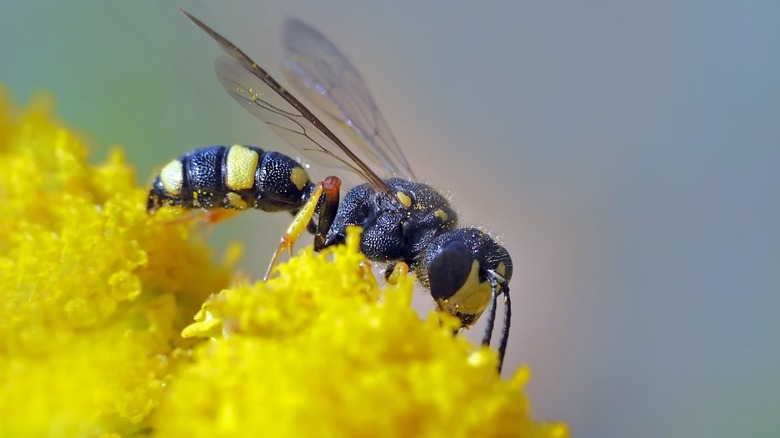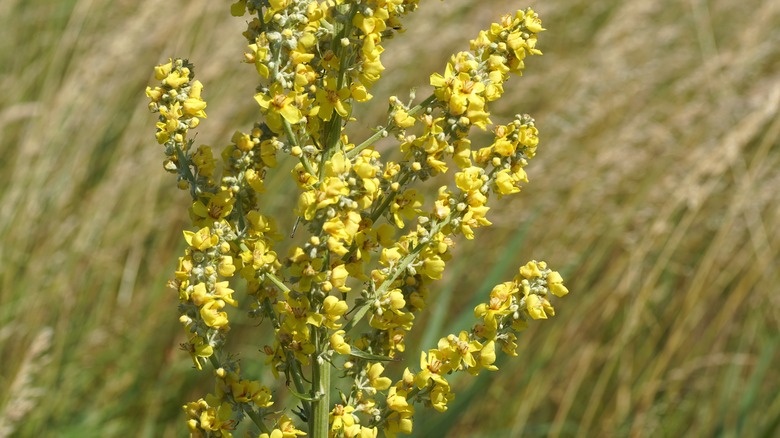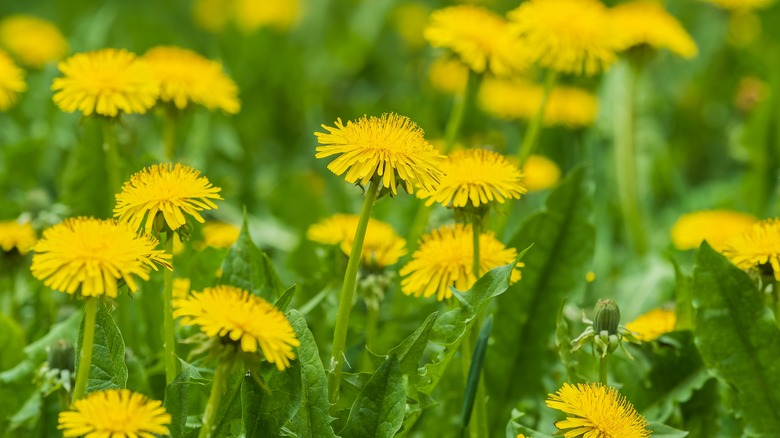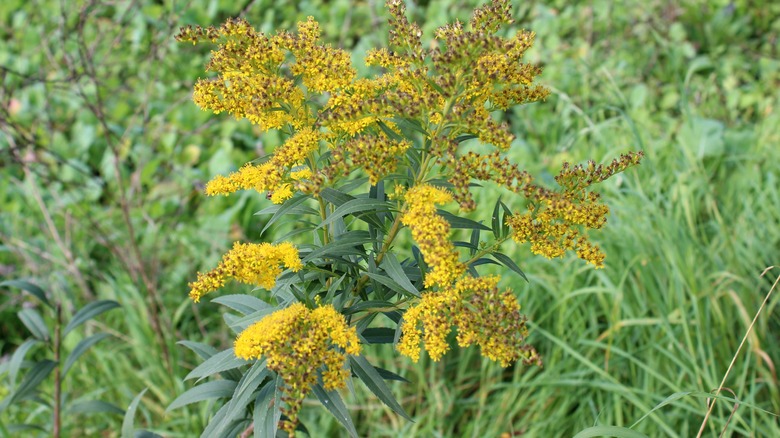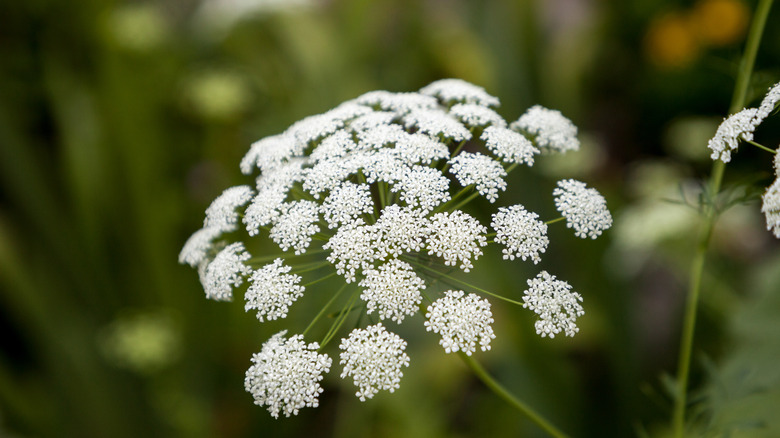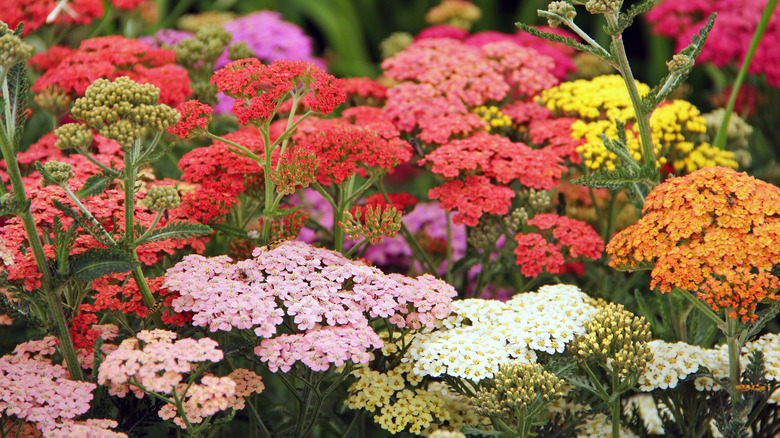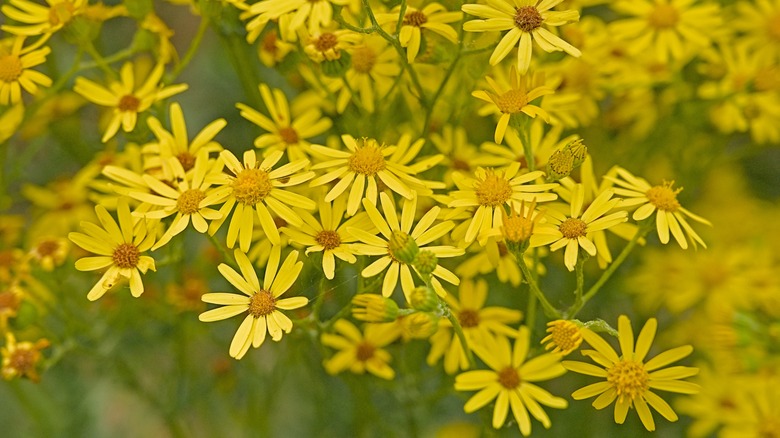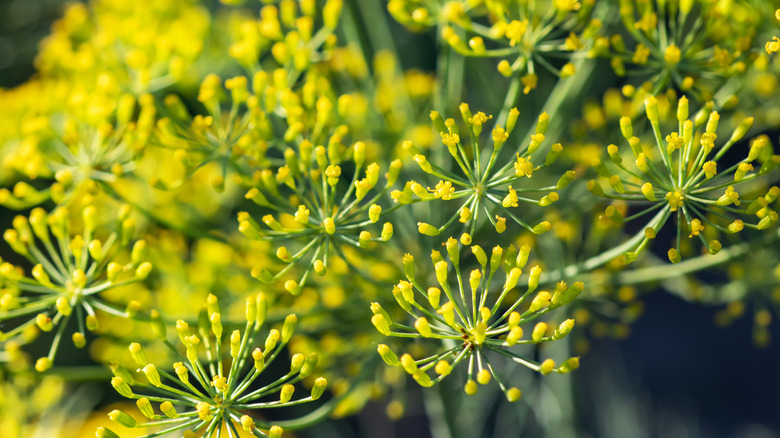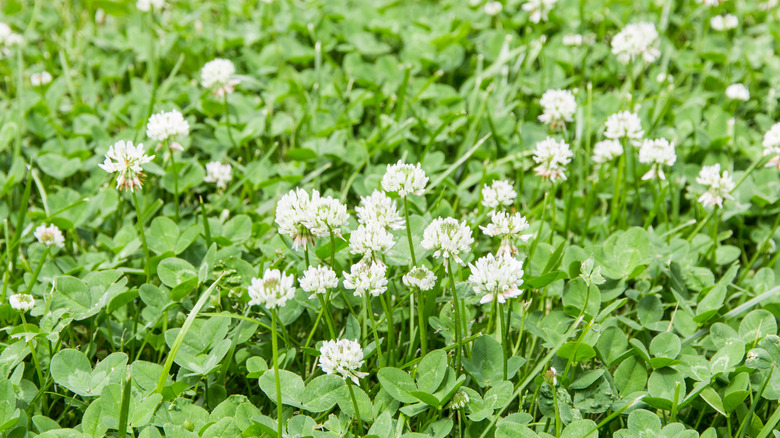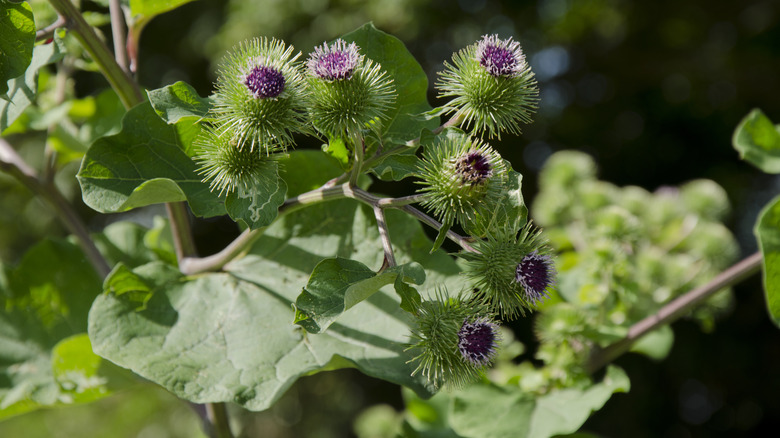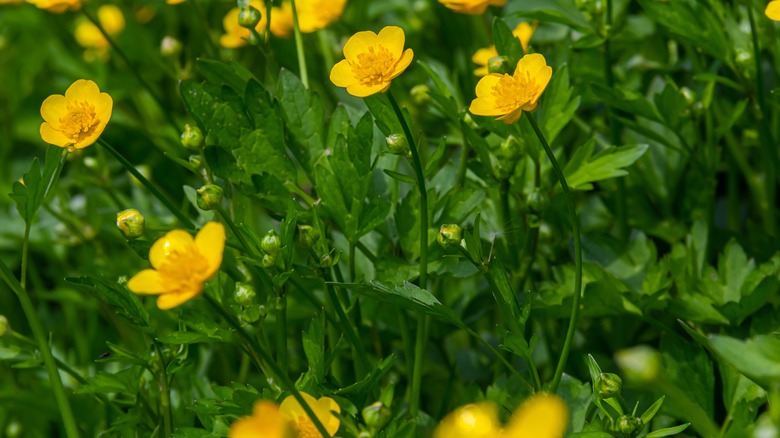Wasp-Attracting Weeds You Don't Want In Your Lawn And Garden
There are certain weeds that wasps prefer more than others for feeding and resting. While nobody wants an outdoor space filled with invasive plants, you can still end up with aggressive weeds taking over your lawn. They also bring along the danger of a wasp sting. These stings hurt, and your reaction may vary in intensity and length. But, getting stung can also end in major disaster if you're allergic.
While wasps can be great pollinators, they can also be aggressive towards humans and pets. Unlike bees who can only get you once because their stinger comes out when they strike, wasps hang onto theirs during an attack. So, you can be stung over and over, depending on how agitated they are, again leading to great pain. By making your yard less appealing to wasps, you can avoid getting hurt. The weeds on this list are well known for providing a good source of food and/or a great habitat for wasps. By keeping them under control, you can help reduce the presence of the insects and make your yard safer and more enjoyable for everyone (except the wasps, of course).
Figwort (Scrophularia) is especially sweet
Wasps love figwort because the weedy plant is known to produce lots of nectar. Because it makes so much more than other plants, it's the perfect place for a hungry wasp to rest and stock up on food. Many might consider this plant a wildflower, but it doesn't really look like one. Instead, it looks a bit like a small tree whose flowers have not yet bloomed. It's very woody and can grow quite tall, making it even more of a nuisance. There are two types of the plant, the S. marilandica which you might encounter if you live in the eastern part of the USA, while S. lanceolata shows up in nearly every mainland state. Yet if you have either version of the plant in your yard, wasps are known to show up.
Figwort is a perennial plant, so if you don't want wasps showing up year after year, you must work efficiently to get rid of the whole system. You can't just trim back this weedy plant. Instead, you have to pull each plant up by its roots and till the soil to make sure nothing that could take hold is left behind. If it's really taken over your yard, attacking it with the lawnmower should also help.
Dandelion (Taraxacum officinale) is quick to take over
Dandelions have pretty bright yellow flowers and wasps think so, too. The weed originally came from parts of Europe and Asia, but has been stateside for so long, it is very common in most of the country. You will recognize it by its sharp yellow petals from which it gets its name "lion's tooth." While some think the flowers are nice to look at, others can be frustrated because the weed grows (and spreads) quite fast. And, when you have a lawn full of dandelions, you often have a lawn full of wasps, which is a pain in more ways than one.
Getting rid of dandelions is tough because of how deep the roots can go and how the seeds spread. Just when you think you've killed them, a few blow in from your neighbor's yard and the process has started over again. While you can use herbicides to start the process of killing them, others find that a more natural approach works best. One way to do this is by covering the impacted area of your yard with wood chips. You want to block out the light to starve the weeds, so make the layer nice and thick. It will take a while to kill them this way, so be patient.
Goldenrod (Solidago species) is like a beacon to wasps
This weed looks exactly what it sounds like. The bright yellow flowers send out a siren song for wasps to gather, as they are a host for two things most wasps enjoy: nectar and smaller bugs to eat. Both paper wasps and potter wasps in particular enjoy goldenrod. The plant can grow tall and tends to look nice, so some might enjoy it in their garden, but if you want to keep wasps away it isn't an option. There are also many different species, so some grow nice and tidy, while others get out of control.
The trouble is you could just as easily end up with a yard of wasps and weeds when all you wanted was a few bright yellow stalks. So, to get rid of them you have to be careful as their seeds can blow in with the wind and quickly take over any open space. Using herbicide doesn't tend to work, as the plants still must be pulled up after they die due to their woody stalks, making for double work. Instead, most experts recommend pulling up the live plants and tilling the soil to make sure the root system is entirely disrupted. They can grow back from the smallest of roots left behind, so you can never be too careful.
Queen Anne's Lace (Daucus carota) is pretty and wasps think so, too
Wasps love Queen Anne's Lace because of its sweet nectar and the many resting places it can provide. In fact, many experts recommend including the weed in your yard if you actually do want to have wasps around — they just love it that much. It gets its name from Queen Anne, the monarch of England in the 1700s, as its delicate white flowers look like the intricate fabric she loved and wore. It is also sometimes called wild carrot. Early colonizers to America brought the weed along with them, and now the plant is an issue for anyone who prefers to keep hungry wasps away from their property.
This weed grows quickly and if left alone, has been known to completely overtake a garden. To get rid of it, the best way is to pull the plants up before you see any flowers. If the weed has flowered, it's already spread its seeds, so you might have another season of fighting it ahead of you. Using methods like burning or herbicides might not be effective, as the plant is resistant to certain chemicals and tends to germinate when warm.
Yarrow (Achillea millefolium) is the perfect landing place for wasps
Because yarrow has many blooms that cluster together in a slightly domed shape with a flat top, pollinators find it easy to rest on its flowers. So if your garden is struggling with lack of growth or has pests like aphids, using yarrow to attract wasps to fix both of these can encourage them to pollinate the plants and eat the pests. Yet, if you want to keep wasps away due to an allergy or general dislike of them, you will also have to skip out on this gorgeous flowering favorite because they simply love it. While the parasitic wasps this weed typically attracts can't sting humans, there is always the possibility that other species might also appear.
And, once you get started with yarrow, it's tough to stop as it is hard to kill with chemicals. That said, the most practical way to control yarrow is simply by pulling it, as you would any other weed. Try to remove as much of the root system as possible to keep it from growing back.
Ragwort (Senecio jacobaea) is wasp heaven
More than 18 species of wasps are drawn to ragwort, so having it in your yard is a big issue if you want to keep the insects away. While the weed is originally from Europe, it has been in the U.S. for generations. It spreads quickly and if ingested by large animals like horses or cows, it can really harm them. So, if you have animals, it is especially important to keep it at bay. Plus, wasps love the tall, woody-stemmed yellow flowers.
To get rid of ragwort, whatever you do, don't mow it down. Experts advise that mowing it will transform it from a plant that will live for a few seasons into one that will respawn each year, almost as a form of vengeance against you. The best way is to pull the weeds before they flower, as each bloom can put out as many as 150,000 seeds into the area. When you pull up the plants, either burn them ASAP, or throw them away in completely sealed bags. If you compost them, they might still grow back. A good way to prevent ragwort from resurging is to replant the area with a plant you actually want, so the weeds don't have a place to grow.
Fennel (Foeniculum vulgare) smells and looks good to the insect
Many different species of wasps love this bright yellow weed, including thread-waisted wasps, potter wasps, and mud dauber wasps. If you want to keep wasps out of your garden, you need to be vigilant to stay ahead of it because fennel can grow like no other. The weed smells nice to most people, a bit like black licorice, but once it takes root, it can quickly outgrow every other plant in its vicinity, strangling them out. It is uncommon to only have a little bit of fennel. Instead, most people quickly find themselves with an infestation of it. This can also quickly lead to a wasp problem.
If you catch fennel early enough, you can remove it by hand. Just make sure to pull the entire root system out, so it cannot grow again. However, the longer it's been growing, the more problems you will have. This is because the bigger plants have deep, intense root networks that can be hard to get rid of. Then, you must cut back the weed before it flowers. Doing this over the years will eventually kill it, as the roots will not continue to grow and it can't spread any more seeds. It's a long process, but worth it to keep your garden wasp-free.
Clover (Trifolium repen) is often planted on purpose, but wasps love it
Some people actually prefer to plant a clover lawn, as the lush padding of small greens gives a different visual appeal than blades of grass. It is also non-toxic if eaten by animals, and doesn't tend to brown when dogs use the restroom in the same spot, making it appealing to pet owners. However, wasps also tend to enjoy clovers and you are likely to find them nestled within the leaves. This can be dangerous, as clover can grow quite close together, creating a little canopy that makes it easy for the insects to hide inside of. This is how you end up stepping on a wasp for the shock of your life. Deciding whether to keep this weed or not is a case of weighing the pros and cons of its benefits against its tendency to attract wasps.
As far as ridding your lawn of clover, the best method is prevention. The weed tends to pop up in lawns that don't have enough nutrients (as it can thrive with almost no care), so fertilizing your lawn can help keep the grass healthy. You can pull the weed out by hand, or simply let your lawn grow a little higher than normal. If you let the grass block out clover, which can't grow too high, it should kill it off over time.
Burdock (Arctium minus) is tall and stubborn
Wasps love burdock because of its sweet and bright flowers which tend to show up in its second year of invasion. They are typically purplish in color and have many long sticks poking out of them in a sort of shell shape. The weed grows quickly and can easily become over six feet tall if left alone. While having it in your yard is likely to attract wasps, it can also be annoying to have around for humans because its little burs act like a lot like Velcro. In fact, the brand based its design on this plant. Once hooked on, they are very difficult to get out of fabric and pet hair.
Pesticides do well to kill burdock, but they tend to kill everything else they touch, too. So, they might not be your first choice. A chemical-free way to get rid of the weed is to cut off the seed pods and destroy them. Then, destroy the base of the plant too to prevent further growth. Because the plant can grow so tall, this is sometimes akin to cutting down a small tree. It's tough work, but one or two summers of keeping up with the burdock on your property should rid you of it — helping to the wasps away, too.
Creeping buttercup (Ranunculus repens) is a wasp favorite
Creeping buttercup tends to pop up in waterlogged areas. It's easy to spot because of its bright yellow flowers, which wasps happen to love. This weed also has little "hairs" on their stems that are easy for wasps to grasp onto. If eaten by pets or livestock, the weed will make them sick.
If you want a wasp-free yard, it's important to stay on top of the maintenance for the weed, as it can spread more than 40 square feet in just one season, so it's easy to get out of control. Because of how fast it goes, if you notice it, move to get rid of it immediately. To keep creeping buttercups out of your lawn, you will need to improve its drainage. Look for low spots and add gravel to reduce standing water. You can also aerate the soil to allow for trapped moisture to better evaporate. While digging up the weed is typically the best way to get rid of it, be careful not to leave any bit of the root system behind. This plant is tenacious and can respawn from almost nothing.
